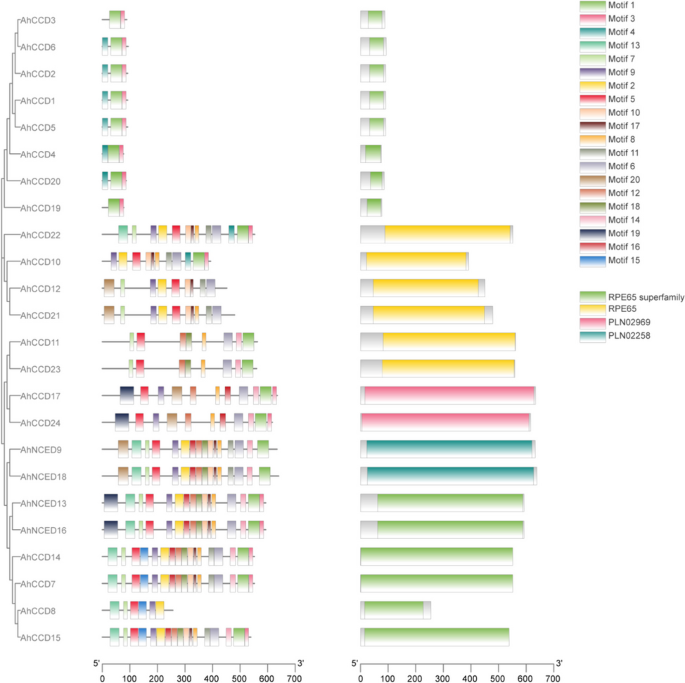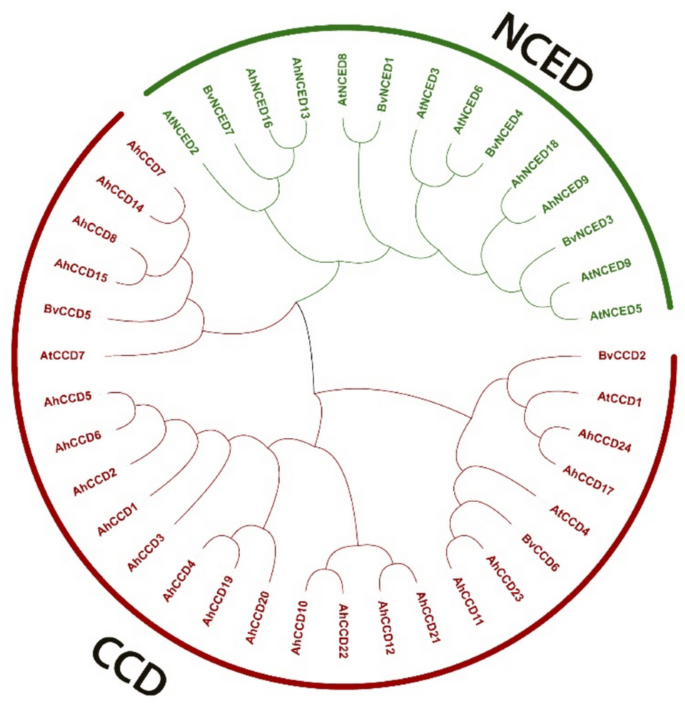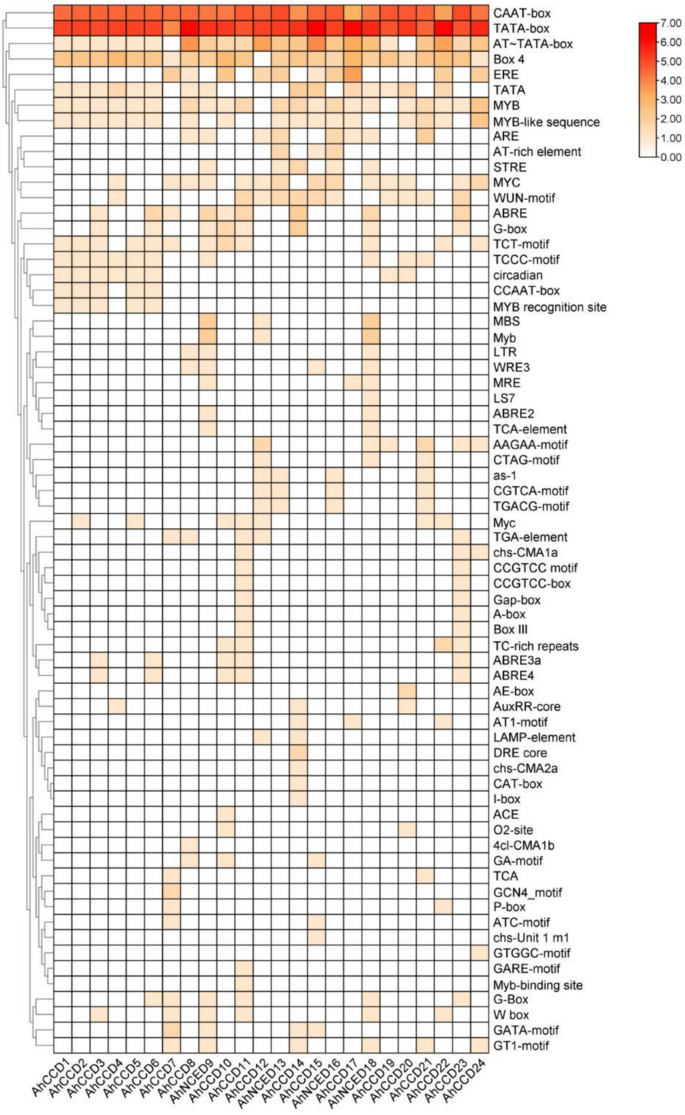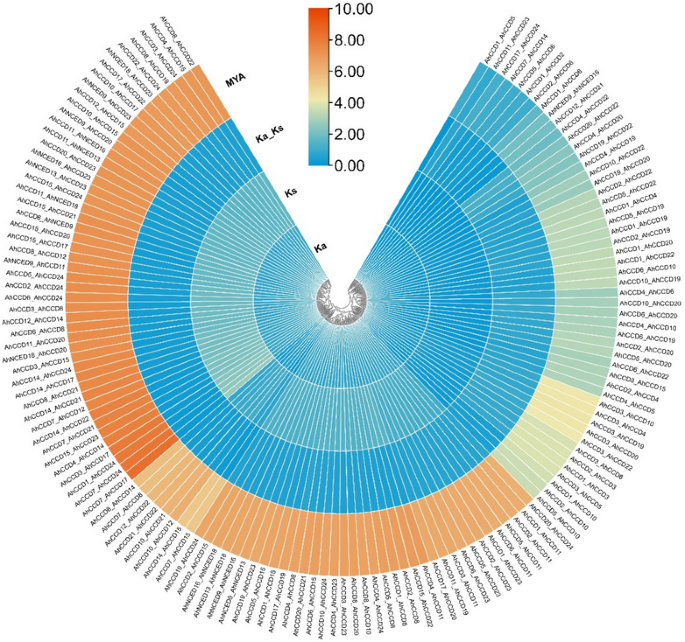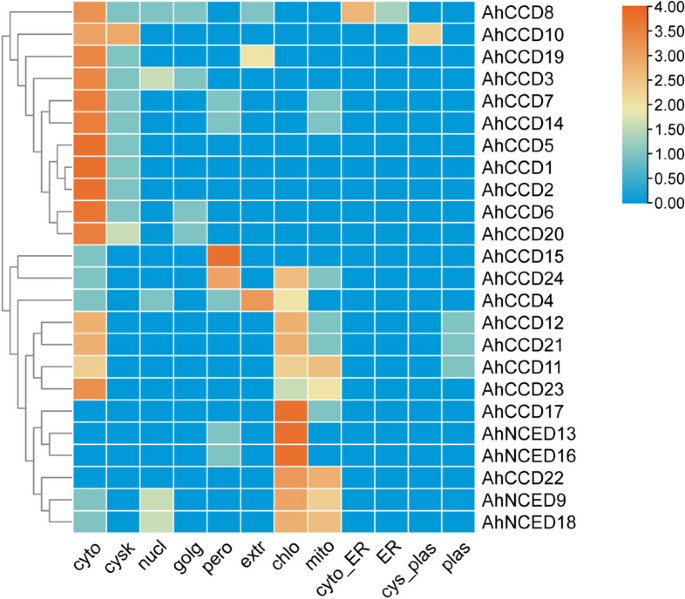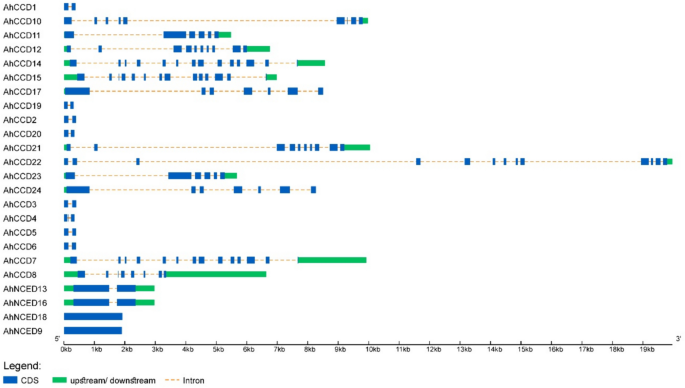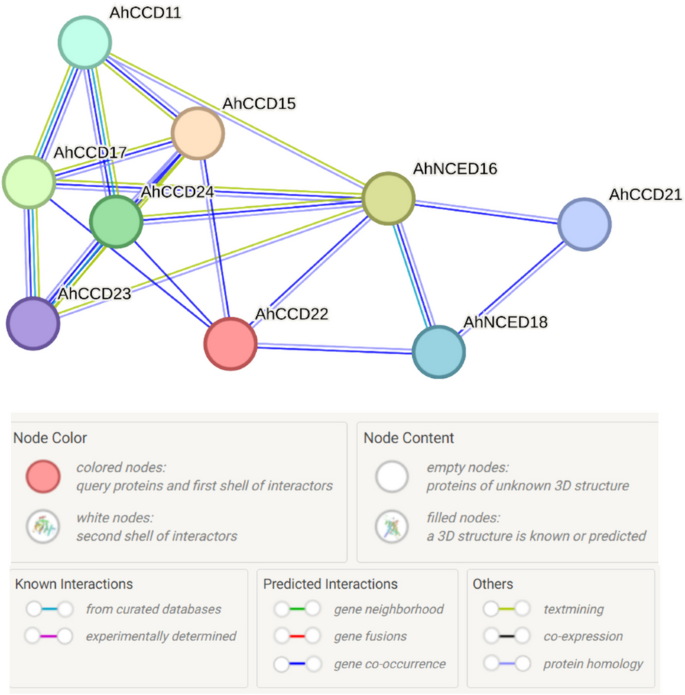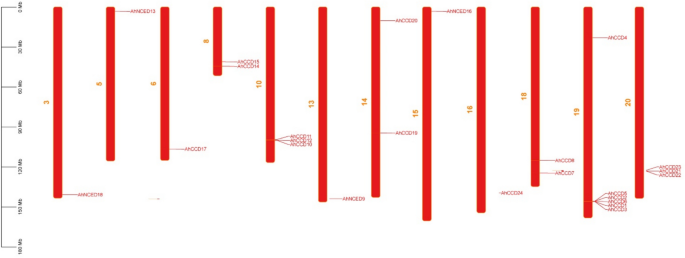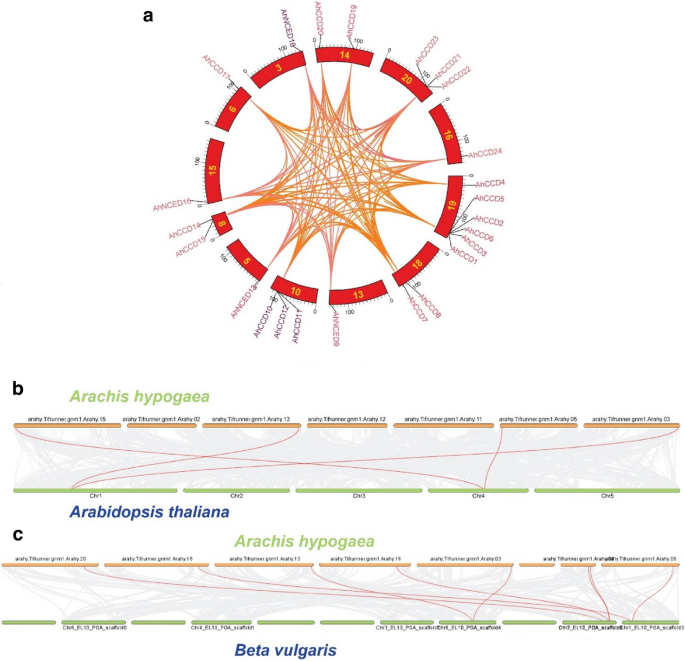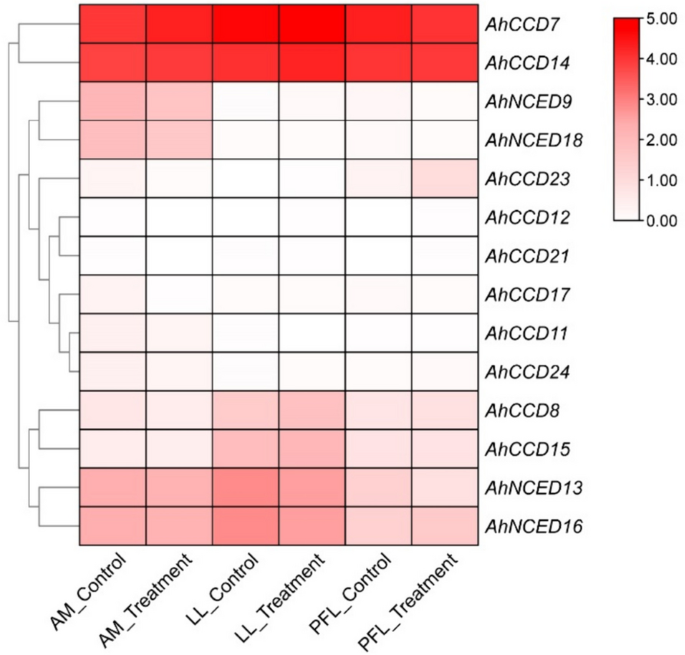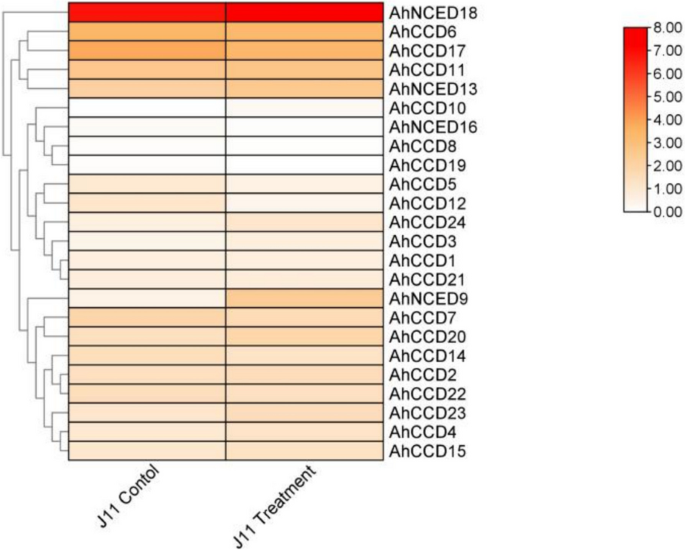- Research
- Open access
- Published:
Genome wide analysis of carotenoid cleavage oxygenases (CCO) gene family in Arachis hypogaea (peanut) under biotic stress
BMC Genomics volume 25, Article number: 469 (2024)
Abstract
Carotenoid cleavage oxygenases (CCOs) enzymes play a vital role in plant growth and development through the synthesis of apocarotenoids and their derivative. These chemicals are necessary for flower and fruit coloration, as well as the manufacture of plant hormones such as abscisic acid (ABA) and strigolactones, which control a variety of physiological processes. The CCOs gene family has not been characterized in Arachis hypogaea. Genome mining of A. hypogaea identifies 24 AhCCO gene members. The AhCCO gene family was divided into two subgroups based on the recent study of the Arabidopsis thaliana CCO gene family classification system. Twenty-three AhCCO genes, constituting 95.8% of the total, were regulated by 29 miRNAs, underscoring the significance of microRNAs (miRNAs) in governing gene expression in peanuts. AhCCD19 is the only gene that lacks a miRNA target site. The physicochemical characteristics of CCO genes and their molecular weights and isoelectric points were studied further. The genes were then characterized regarding chromosomal distribution, structure, and promoter cis-elements. Light, stress development, drought stress, and hormone responsiveness were discovered to be associated with AhCCO genes, which can be utilized in developing more resilient crops. The investigation also showed the cellular location of the encoded proteins and discovered that the peanut carotenoid oxygenase gene family’s expansion was most likely the result of tandem, segmental, and whole-genome duplication events. The localization expresses the abundance of genes mostly in the cytoplasm and chloroplast. Expression analysis shows that AhCCD7 and AhCCD14 genes show the maximum expression in the apical meristem, lateral leaf, and pentafoliate leaf development, while AhNCED9 and AhNCED13 express in response to Aspergillus flavus resistance. This knowledge throws light on the evolutionary history of the AhCCO gene family and may help researchers better understand the molecular processes behind gene duplication occurrences in plants. An integrated synteny study was used to find orthologous carotenoid oxygenase genes in A. hypogaea, whereas Arabidopsis thaliana and Beta vulgaris were used as references for the functional characterization of peanut CCO genes. These studies provide a foundation for future research on the regulation and functions of this gene family. This information provides valuable insights into the genetic regulation of AhCCO genes. This technology could create molecular markers for breeding programs to develop new peanut lines.
Introduction
Carotenoid cleavage oxygenase (CCO) is an enzyme that plays a role in the biosynthesis of the phytohormones ABA and strigolactone (SL) as well as in biological functions such as light absorption, electron transfer, and oxygen-free radical removal [1]. These are non-heme iron oxygenases that help in carotenoids oxidate remodeling and produce apocarotenoids, which control phytohormone regulation, pigments, and defensive compounds in plants [2]. There are approximately 50 carotenoids that are specifically precursors of vitamin A, which play a key role against cancer disease. It also contributes to the color of fruits like red, yellow, and orange [3]. CCO have has conserved histidine that might help in iron-binding and also contain a peptide sequence at the carboxyl terminus that constitutes a family signature sequence. In A. thaliana, the CCO gene family have nine members [4]. Out of nine, two CCDs are involved in sequential cleavage that is stimulated by CCD7 and CCD8, which produce shoot-branching inhibiting hormone [5]. The CCO genes belong to a long-established family. The maize (Zea mays) abscisic acid -deficient viviparous mutant, vp14, had the first CCO gene expression. Later, nine vp14 homologs were found in A. thaliana [6]. These are terpenoid substances made by phototrophic organisms, such as plants, certain eubacteria, and fungi [7]. In order to create different apocarotenoids and their derivatives, CCOs can precisely cleave the conjugated double bond of the carotenoid polyene chain. Plant CCOs can be further divided into the 9-cis-epoxycarotenoid (NCED) and carotenoid cleavage dioxygenase (CCD) subfamilies based on whether the substrates are epoxidized.
Abscisic acid (ABA) is a 15-C weak acid discovered in the 1960s that has a variety of functions in plant development and growth, including embryo maturation, seed dormancy, germination, cell division and elongation, floral induction, and responses to environmental challenges such as pathogen attack, dehydration, salinity etc [8]. Initially thought to be a growth inhibitor, abscisic acid is now recognized as a crucial plant hormone that controls plant growth [9]. ABA not only regulates the stomatal pathway but is also involved in gene expression and regulating cis-acting elements [10]. Disease resistance is negatively regulated by ABA’s interference with biotic stress signaling, which is controlled by salicylic acid, jasmonic acid, and ethylene [11].
In plants, carotenoid cleavage dioxygenase (CCD) emits several volatile phytohormones and aroma compounds. The actual cleavage mechanism is still not understood. This enzyme group has more importance in terms of nutritional value. These hormones cause symbiotic mycorrhizal fungi to branch and attach to plant roots, or they can be transmitted to plant aerial portions to prevent branching or tillering, which is a major agronomic feature in grasses [12]. CCD is known specifically for its double bond cleavage, which is different in plants and animals. The catalization occurs at 9, 10, and 9′, 10′ double bonds [13]. Carotenoids serve as precursors in the synthesis of regulatory molecules within plants, including β-cyclocitral, as well as newly identified regulatory metabolites like anchorene, iso-anchorene, and zaxinone. These derivatives are made by selective oxidative cleavage of carotenoids, primarily triggered by CCDs [14]. CCD genes have distinct functions in different crops: in tomatoes, they contribute to flavor volatiles; in petunias, β-ionone (a recognized key contributor to floral fragrance in various plant species [15]) synthesis; and in Brassica oleracea, responses to drought and salt stresses [2]. In grapevine, CCD is known for producing the flavor and aroma related apocarotenoid in both fruits and flowers [5]. In the grapevine, it has been discovered that a total of nine CCDs genes play a crucial role in the synthesis of the shoot-branching inhibiting hormone, strigolactone. This synthesis process is specifically enhanced through sequential cleavage catalyzed by the Arabidopsis CCD7 and CCD8 genes [16].
9-cis-epoxycarotenoid dioxygenase (NCED) is also an essential enzyme that stimulates ABA biosynthesis, as shown by genomic studies of plants [17]. It was cloned from the maize plant and then from other plant species responsible for the production of xanthoxin (an intermediate compound in ABA synthesis) [18]. Now the NCED gene has been translated and expressed in various plants, including beans, cowpeas, avocados, grapes, Arabidopsis, sweet cherries, and citrus, since it was first discovered in the maize vp14 mutant. In sweet cherries, the NCED gene (PavNCED5) influences the bud dormancy [19]. The expression of NCED (PvNCED1) in Phaseolus vulgaris under drought conditions demonstrated a substantial connection between NCED (PvNCED1) and ABA levels in dry leaves and roots, suggesting that NCED controls ABA production under water stress [20]. Tobacco and tomato were the first plants in which overexpression of NCED resulted in excessive accumulation of ABA. In tomato, this led to greater water usage efficiency due to an increase in root hydraulic conductivity and a decrease in stomatal conductance (gs) [21]. In rice, the NCED genes OsNCED6 and OsNCED10 defend against salt stress, whereas OsCCD7 and OcCCD8 are involved in grain and inflorescence development [22].The genes HaNCED16 and HaNCED19 were expressed in response to drought stress revealed in recent studies [23].
Peanuts are an economical and nutritious source of food worldwide. A. hypogaea produces different products like peanut butter and peanut oil that help to meet nutritional values as well as lower body mass index (BMI) [24]. A total of 24 AhCCO genes were discovered that might play a role in peanuts’ resistance to various fungal pathogens. The cis-elements of A. hypogaea regulate responses to low temperature and light, anaerobic induction, jasmonate signaling, and both biotic and abiotic stress [25, 26]. ABA plays a key role in regulating physiological processes like fruit development, biotic and abiotic stresses. In this study, we identified CCO genes from the peanut genomes and investigated their evolutionary relationship, gene structure, protein motifs, and expression profiles in various organs, stages of fruit development, and responses to abiotic and biotic stress. This discovery expands our understanding of CCO genes involved in growth, development, and stress responses and provides the basis for peanut genetic enhancement.
Materials and methods
Identification of the CCOgene family, Physiochemical properties and subcellular localization
The CCO protein sequence was retrieved from the National Center for Biotechnology Information (NCBI) with the domain RPE65. The protein sequence of A. hypogaea, along with (A) thaliana and (B) vulgaris, was retrieved from the phytozome database (https://phytozome-next.jgi.doe.gov/, accessed on June 2, 2023). The genes with conserved RPE65or PF03055 domains were considered the true CCO genes. Physicochemical properties of the CCO protein in A. hypogaea, such as mRNA length, chromosomal start and end position taken from the Phytozome and other parameters such as number of amino acids, molecular weight, theoretical pI value, grand average of hydropathicity (GRAVY), instability index, were taken from the ExPASy (https://web.expasy.org/protparam/, accessed on June 4th, 2023) online tool and protein subcellular localization prediction using WoLF PSORT (https://wolfpsort.hgc.jp/, accessed on June 7th, 2023).
Analysis for comparative phylogenetic tree
The analysis was performed between the peptide sequences of A. hypogaea, (A) thaliana, and (B) vulgaris for the construction of a phylogenetic tree. The CCO sequence of proteins that was used to make a phylogenetic tree in MEGA-11 (https://www.megasoftware.net/) software with the method of neighbor-joining (NJ) and setting 1000 replications for the bootstrapping value. The final structure was done on iTOL (https://itol.embl.de/).
Conserved motif analysis and gene structure
The conserved motifs of CCO gene family proteins in A. hypogaea were examined using Multiple Expectation Maximization for Motif Elicitation (MEME) (https://meme-suite.org/meme/tools/meme). The motif’s maximum value was set to 20, and its maximum length ranged from 6 to 50. The conserved motifs were then shown using the TB-tools (https://bio.tools/tbtools) program. The intron exon substructure of CCO family genes was visualized using analytical tools from the Gene Structure Display Server (GSDS, https://gsds.gao-lab.org/ , accessed on June 13th, 2023).
Chromosomal Location of AhCCO genes
Phytozome (https://phytozome-next.jgi.doe.gov/) provided details about the CCO locations, including the length of the chromosome, the chromosome it is on, and its precise location within the chromosome. Using the TB-tools software, the image displaying the location of CCO on the chromosome was created.
Cis regulating gene analysis
The 1000-bp upstream sequence of the translation initiation codon of AhCCO was extracted from the Phytozome on June 15th, 2023.
PlantCare (https://bioinformatics.psb.ugent.be/webtools/plantcare/html/ , accessed on June 14th, 2023) database was used for cis-acting regulatory element prediction.
MiRNA analysis and protein-protein interaction
Using the CDS sequences of all the CCO genes with the default parameters, psRNATarget (https://www.zhaolab.org/psRNATarget/ , accessed on June 17th, 2023) was used to find the AhCCO gene-related micro-RNA (miRNA) sequences. The STRING database was used to predict potential interactions among the proteins (https://string-db.org/ , accessed on June 18th, 2023).
Gene duplication and synteny analysis
Ka/Ks ratios were used to estimate the divergence time of the AhCCO genes. The substitution rates were calculated using TB-tools. The Ks value was entered into the “T = Ks/2r” equation, where “r” is equal to 8.12*10^-9, to estimate the time of divergence (DT) [27]. MCScanX v1.0 (Multiple Collinearity Scan toolkit) was used to analyse the gene duplication occurrences. Syntenic and dual syntenic maps were created in order to determine the synteny link between the genes of A. hypogaea, (A) thaliana and (B) vulgaris.
Transcriptomic analysis/gene expression analysis
RNA seq analysis data of the AhCCO gene was extracted (GEO; accessed on June 23rd, 2023; accession no. GSE180915) from different plant parts like the lateral leaflet and terminal leaflet using petioles and seeds to study the transcriptomic effect on compound leaf development in A. hypogaea. Another piece of data from the RNA-seq study of the AhCCO gene was used to study the resistance of peanut pre-harvest seeds in response to Aspergillus flavus. Data related to compound leaf development of peanut and response to A. flavus retrieved from the NCBI Gene Expression Omnibus (GEO) (accessed on June 26th, 2023; accession no. GSE102782).
Results
Identification of genes in peanut
In a genome-wide study of peanuts, 24 CCO genes were identified (Table 1). Gene names, chromosomal locations, chromosomal direction, gene lengths, exon numbers, molecular weights (Mw in kDa), protein size, and isoelectric points (pI) are also shown in Table 1. This study shows the coding sequence (CDS) ranges from 231 bp (bp) (AhCCD4) to max. 1905 bp (AhCCD17), while the molecular weight (Mw) lies between 8612.91 (AhCCD4) and 71589.99 (AhCCD17) in all 24 genes of peanut. The following CCO gene lengths range from 76 (AhCCD4) to 633 (AhNCED9), and pI values vary from 4.62 (AhCCD19) to 8.64 (AhCCD3).
Analysis for miRNA (MicroRNA) target site
MiRNA target site prediction shows that there were 29 miRNA target sites in 23 (95.8%) AhCCO genes (including CCD and NCED). 12 mature miRNAs (nucleotides) specifically target the gene AhCCD15, whereas 11 miRNAs target the genes AhNCED9 and AhCCD22. Other genes are targeted by mature miRNAs ranging from 1 to 10. AhCCD19 is the only gene that lacks a particular miRNA. In all genes, the length of these miRNAs varies from 16 to 22. 20 miRNAs observed play a significant role in cleavage, while 25 control translation. Some of them are involved in both cleavage and translation.
Conserved motif domain analysis for CCO gene family
The conserve domain motif analysis depicts that all motifs are conserved under the domain of the superfamily RPE65. In addition, Fig. 1 comprehensively shows that genes AhCCD12, AhCCD19, and AhCCD20 have two motifs, while AhCCD10, AhCCD21, AhCCD4, AhCCD3, AhCCD1, AhCCD2, AhCCD5, and AhCCD6 have 3 motifs only. All remaining genes have motifs that vary from six to seventeen, but motif-1 was conserved and is present in all genes of A. hypogaea, as shown in Fig. 1.
Phylogenetic relationship of CCO protein
The construction of the phylogenetic tree of the CCO proteins of A. hypogaea, B. vulgaris, and A. thaliana was done in Mega-11 software (Fig. 2). The analysis exhibits 24 genes of A. hypogaea, seven of B. vulgaris, and nine of A. thaliana contributing to the phylogenetic tree. Genomic tree visualizes two main groups, CCD and NCED, in sugarbeet, peanut, and Arabidopsis evolutionary analysis. Group-1 contain all CCD genes shown in red, while Group-2 contain NCED shown in green.
Illustrates the phylogenetic relationships among 40 CCO genes from three plant families: A. hypogaea, (A) thaliana and (B) vulgaris. Groupings are established through Arabidopsis phylogenetic tree reconstruction and evolutionary trait analysis. This figure visually represents the division of these 40 CCO genes among the three crop species, following the Arabidopsis phylogenetic grouping system
Cis regulatory element (CREs) analysis
The CAT-box, which is a cis-acting regulatory element related to meristem expression, was found to exist in one AhCCO promoter (Fig. 3). A number of cis-acting elements involved in phytohormone-responsiveness, such as AuxRR-core, CGTCA-motif, TGACG-motif, TGA-element, ABRE, P-box, GARE-motif, and TCA-element, were identified in the CCO promoters. Methyl jasmonate-responsive elements, including CGTCA-motif and TGACG-motif, appeared in most CCO promoters. Notably, ABRE, which is involved in ABA responsiveness, was observed in most of CCO promoters. There were also many types of stress-induced cis-acting elements in the CCO promoters, such as ARE, LTR, MBS, TC-rich repeats, DRE, and GC-motif. ARE is essential for anaerobic induction and was found in most promoters (seven out of 24 AhCCO promoter). TC-rich repeats, which are involved in defense and stress responsiveness, were detected in five AhCCO promoters. The LTR cis-acting elements, which are involved in low-temperature, responsiveness, were found in many promoters (three AhCCO). The DRE cis-acting element, which is involved in dehydration, low-temperature and salt stress, was specific to the AhCCO promoter, while the GC-motif involved in anoxic specific inducibility only existed in the AhCCO promoters. GTGGC-motif, I-box, LS7, chs-CMA2a, chs-Unit 1 m1, 4cl-CMA1b, and ACE that are present in genes AhCCD24, AhCCD14, AhNCED18, AhCCD14, AhCCD15, AhCCD8, AhCCD10 respectively play important role in regulating light-responsive elements, and GARE-motif controls the gibberellin-responsive element that play a role in signal transduction, grain germination, and certain transcription factors that regulate gene expression.
Gene duplication and gene mapping of CCO genes
The gene duplication of CCO was calculated using TB-tools (Fig. 4). The ka/ks (non-synonymous substitution rate and synonymous substitution rate) values that show the CCO genes of A. hypogaea range from 0 (AhCCD1_AhCCD5), which is the lowest, to value 1.45 (AhCCD20_AhCCD22), which is the highest among all. The paralogous-gene pair AhCCD7_AhCCD17 has the greatest value of 346.442478 (million years ago) and the lowest value of 0.786267402 (million years ago) of gene pair AhCCD11_AhCCD23 for segmental duplication. The ka/ks value less than 1 indicates purifying selection, except gene pairs (AhCCD4_AhCCD20, AhCCD19_AhCCD22, AhCCD4_AhCCD22, and AhCCD20_AhCCD22) have a value greater than 1 indicating positive or diversifying selection [28, 29]. Gene mapping analysis reveals the presence of a single gene on chromosomes 3, 5, 6, 13, 15, and 16. Chromosomes 8, 14, and 18 each harbor two genes, while chromosomes 10 and 20 contain three genes. Chromosome 19 stands out with six identified genes.
Sub-cellular localization of CCO genes
In peanuts, the localization of CCO genes within cells is abundant, most in the cytoplasm and chloroplast (Fig. 5). Other organelles, like the peroxisome and mitochondria, also contain CCO genes in quantity but less in number.
The heat map displays the sub-cellular distribution of AhCCO genes in plant cells, indicating their presence in the nucleus, cytoplasm, chloroplast, golgi apparatus, mitochondria, plasmid, and peroxisomes. Blue signifies absence, white suggests minimal functional presence, and mild orange indicates significant functional importance of the gene in the specific region
Intron/exon structure analysis
The intron-exon analysis shows that 10 out of 24 genes have just two exons and one intron. These genes might be descended from a common ancestor. Two genes contain only one exon and no intron. Other genes have exon-intron ranges from 14–13 as the maximum to a 7–6 ratio as the minimum (Fig. 6). The research demonstrates how different genes with the same number of exons and introns predict gene structure.
The phylogenetic representation of the intron-exon structure demonstrates that NCED genes have fewer coding sequences than CCD genes. In the meanwhile, the some NCED and CCD gene are conserved in the number of introns and exons. Genes AhCCD14 and AhCCD15 have highest exons of 14 while AhNCED9 and AhNCED18 have least of only one exon
Protein-protein interaction of different genes
Only nine genes (out of 24) show linkage that describes the tight interaction with their molecular structure in protein-protein interaction structure analysis. The genes AhCCD24, AhCCD17, and AhNCED16 have the most linkage (Fig. 7), whereas AhCCD22 and AhCCD21 have the least, according to the STRING database [30]. These genes are involved in a variety of roles, including biological processes and molecular functions.
Chromosomal localization of AhCCO genes
There are a total of 12 chromosomes found, containing 24 peanut CCO genes spread on different chromosomal numbers (Fig. 8). Chromosome 19 has the most genes (6 genes; 25%), chromosome 10 and 20 have 3 (12.5%), chromosome 18, 8, 14 have 2 (8.3%), and chromosome 13, 15, 5, 6, 3 and 16 have only single genes (4.16%).
Additional analysis of synteny (depicted in Figs. 9a, b, and c) revealed the genetic linkage between chromosome 1 of A. thaliana and A. hypogaea genes (AhNCED9, AhNCED18), and chromosome 2 of A. thaliana with genes (AhNCED13, AhNCED16). Furthermore, the linkage was observed between chromosomes 1, 2, and 8 of B. vulgaris with A. hypogaea genes (AhNCED9, AhNCED18), genes (AhCCD14, AhCCD15, AhCCD8, AhCCD11, AhCCD23), and genes (AhCCD17, AhCCD24) respectively.
To reveal the similarity and gene duplication distribution, single (a) and additional dual synteny analyses of A. hypogaea were conducted. Arachis-Arabidopsis (b), Arachis-Beta (c) depicted the linkage gene duplication of both specimens. The genomes mentioned plant species have been found to share minor structural and gene duplication sharing
Gene expression analysis of different A. hypogaea organ
A brief study of the CCO gene family in the context of A. hypogaea (peanut) research has resulted in the discovery of 24 genes. Four of these genes (AhCCD7, AhCCD14, AhCCD23, and AhCCD17) have been found to be up-regulated in the apical meristem (AM) (Fig. 10). The gene AhCCD14 is up-regulated during lateral leaf (LL) development; however, another two genes (AhCCD12 and AhCCD21) are up-regulated during pentafoliate leaf (PFL) development. Significantly, one gene from the apical meristem, two from the lateral leaf, and one from the pentafoliate leaf development stages indicate down-regulatory patterns. This study shows the complex regulatory role of these genes in different phases of A. hypogaea growth, stress responses, the nutrient cycle and gas exchange mechanisms also in development.
Heatmap show the development of compound Lateral leaf (LL), Apical Meristem (AM) and Pentafoliate Leaf (PFL) Triggered by up-regulatory genes shown. AM Control, LL Control and PFL Control were the Leaves of Mutant cultivar of peanut plant while AM Treatment, LL Treatment and PFL Treatment were the wild type
Gene expression analysis of biotic stress on A. hypogaea plant parts and resistance
The observed response of two distinct genes out of 24, AhNCED9 and AhNCED13, both of which exhibit considerable up-regulation, is especially important to our investigation (Fig. 11). This elevated expression profile is seen in the context of peanut pre-harvest seeds that demonstrated resistance to the fungus A. flavus [31]. A single gene in the investigated retrieval seems to be down-regulated, increasing the variety of regulatory responses. This in-depth assessment reveals the genetic complexity behind the peanut plant’s resistance mechanisms in combating the effects of the fungal disease, providing a description of potential approaches to enhancing peanut crop resilience and productivity in the presence of A. flavus.
Discussion
Using bioinformatics tools, an enormous number of CCOs genes have been found and analyzed in many species in recent years. Advancements in the AhCCO peanut family’s research and development have lagged behind those seen in other species. There is currently inadequate information available on CCOs in A. hypogaea. The major mechanisms driving species evolution, producing novel gene functions, and fostering the creation of gene families are gene loss and duplication. Members of the CCO gene family have been found in a variety of plants. Gene duplication indicates the diversifying or purifying selection based on ka/ks value. Four AhCCD paralogous-gene pairs show diversifying selection because of ka/ks values greater than 1 among all. This categorization further aids in discerning gene functions based on their respective categories. As a result, phylogenetic analysis could play a role in the development of functional genomics. The phylogenetic analysis predicts the gene categorization of CCD and NCED in different crops like A. hypogaea, B. vulgaris, and A. thaliana and also shows the genes that are involved in pigmentation and stress response. A. hypogaea, B. vulgaris, and A. thaliana show four (16%), six (66%), and four (57%), respectively, of NCED genes in a total of twenty-four, nine, and seven CCO genes in crops. The NCED subfamily likely diverged after dicots and monocots split, while the CCD subfamily diverged before angiosperms split. The phenomenon of CCO gene variances could be the result of gene duplication in various crops. The intron-exon structure analysis (Fig. 6) shows the genes that have a range of intron-exons 6-7 to 14–13, except for two AhNCED genes (AhNCED9 and AhNCED18) that are intronless. This intron-deficient structure used to be believed to be critical for plants’ quick response to stress via ABA production and ABA-mediated signal transduction [32]. In general, most AhCCO genes contain two exons. In the present investigation, a substantial proportion of AhCCO genes, specifically 20 genes (83.3%), exhibited cytoplasmic abundance, while 12 genes (50%) were identified within the chloroplast, and 11 genes (45.8%) were located within the mitochondria. Notably, the genes detected within the chloroplasts are likely implicated in chlorophyll synthesis via the photosynthesis pathway.
The conserved motif domain-RPE65 expresses the motif compositions and gene structures that are widely distributed in 24 AhCCO genes and exhibit the range of motif from 6 to 17, except that 2 (8.33%) AhCCD genes express exclusively two motifs and eight (33.3%) AhCCD genes express three motifs. Previous research has shown that CCO genes play essential roles in ABA regulation and plant stress response [20, 33]. The 24 AhCCO genes were found on all 12 chromosomes; however, chromosome 19 has the most genes (25%), while the others have less than 12%. The CCO promoters also contained a variety of stress-induced cis-acting elements, including ARE, LTR, MBS, TC-rich repeats, DRE, and GC-motifs. However, most of the AhCCO promoters contained an ABRE cis-element, which has significance in ABA responsiveness [34, 35].
Plant reactions to biotic and abiotic stress have been discovered to be triggered by miRNAs [36, 37]. Several miRNA families were predicted to regulate the expression of CCO genes in peanut, but ahy-miR394 miRNA that plays a role in regulating plant defense responses to abiotic stress revealed in our research [26]. It was predicted that ahy-miR394 targets the CCO gene (AhCCD15), which suggests that it could be involved in abiotic stress regulation. Other miRNA may have a role in ABA regulation and several stress responses. Gene expression patterns are frequently associated with gene function. The transcriptomic analysis reveals the multifaceted influence of distinct CCD and NCED genes on the biotic stress response, growth, and development of A. hypogaea. These findings provide insights into the diverse contributions of CCD (AhCCD12, AhCCD21)genes to the development of various plant parts such as the lateral (LL), apical meristem (AM), and pentafoliate leaf (PFL), as well as their involvement in abiotic stress responses. Conversely, the NCED genes (AhNCED9 and AhNCED13) appear to be particularly associated with pathogenic fungal resistance, representing a distinct and specialized role in the plant's defense mechanisms. These genes help the peanut plant regulate the nutrient cycle and growth of compound lateral and pentafoliate leaf development.
Conclusion
This is the most comprehensive study of the AhCCO gene family in terms of evolutionary relationships, gene structures, conserved motifs, cis-acting areas, and gene expression patterns in A. hypogaea. The study of these AhCCO genes reveals their evolutionary relationship to other CCO genes from different crops and helps to find out their closely related functions. Furthermore, an extensive study of cis-acting elements inside CCO gene promoters revealed an abundance of cis-acting elements involved with important functions such as growth, development, phytohormone response, and stress response. The finding precisely suggests that the CCO gene family could be involved with a variety of regulatory and transcriptional processes. Subcellular localization predictions demonstrated that a significant amount of AhCCO proteins are functionally located inside the cytoplasm and chloroplast. Particularly, the gene expression study revealed that AhCCD7 and AhCCD14 were overexpressed during the early stages of the development of compound leaves, whereas AhNCED18 was over-expressed in response to biotic stresses such as pathogenic fungal resistance. The findings of this research hold important significance for improving our understanding of the genetic complexities underlying AhCCO genes. Furthermore, these results provide potential for encouraging the development of more robust A. hypogaea cultivars capable of withstanding both growth barriers and biotic stresses, thus contributing to the long-term improvement of peanut farming.
Availability of data and materials
All data generated or analyzed during this study are included in this published article.
References
Auldridge ME, Block A, Vogel JT, Dabney-Smith C, Mila I, Bouzayen M, Magallanes‐Lundback M, DellaPenna D, McCarty DR, Klee HJ. Characterization of three members of the Arabidopsis carotenoid cleavage dioxygenase family demonstrates the divergent roles of this multifunctional enzyme family. Plant J. 2006;45(6):982–93.
Su W, Zhang C, Feng J, Feng A, You C, Ren Y, Wang D, Sun T, Su Y, Xu L. Genome-wide identification, characterization and expression analysis of the carotenoid cleavage oxygenase (CCO) gene family in Saccharum. Plant Physiol Biochem. 2021;162:196–210.
Zhang X, Liu H, Guo Q, Zheng C, Li C, Xiang X, Zhao D, Liu J, Luo J, Zhao D. Genome-wide identification, phylogenetic relationships, and expression analysis of the carotenoid cleavage oxygenase gene family in pepper. Genet Mol Res. 2016;15(4):15048695.
Auldridge ME, McCarty DR, Klee HJ. Plant carotenoid cleavage oxygenases and their apocarotenoid products. Curr Opin Plant Biol. 2006;9(3):315–21.
Lashbrooke JG, Young PR, Dockrall SJ, Vasanth K, Vivier MA. Functional characterisation of three members of the Vitis vinifera L. carotenoid cleavage dioxygenase gene family. BMC Plant Biol. 2013;13:1–17.
Chen H, Zuo X, Shao H, Fan S, Ma J, Zhang D, Zhao C, Yan X, Liu X, Han M. Genome-wide analysis of carotenoid cleavage oxygenase genes and their responses to various phytohormones and abiotic stresses in apple (Malus domestica). Plant Physiol Biochem. 2018;123:81–93.
Zhao J, Li J, Zhang J, Chen D, Zhang H, Liu C, et al. Genome-wide identification and expression analysis of the carotenoid cleavage oxygenase gene family in five rosaceae species. Plant Mol Biol Rep. 2021;39:739–51. https://doi.org/10.1007/s11105-021-01284-9.
Finkelstein R. Abscisic acid synthesis and response. Arabidopsis Book. 2013;11:e0166.
Zeevaart JA, Creelman RA. Metabolism and physiology of abscisic acid. Annu Rev Plant Physiol Plant Mol Biol. 1988;39(1):439–73.
Leung J, Giraudat J. Abscisic acid signal transduction. Annu Rev Plant Biol. 1998;49(1):199–222.
Mauch-Mani B, Mauch F. The role of abscisic acid in plant–pathogen interactions. Curr Opin Plant Biol. 2005;8(4):409–14.
Vallabhaneni R, Bradbury LM, Wurtzel ET. The carotenoid dioxygenase gene family in maize, sorghum, and rice. Arch Biochem Biophys. 2010;504(1):104–11.
Tan BC, Joseph LM, Deng WT, Liu L, Li QB, Cline K, McCarty DR. Molecular characterization of the Arabidopsis 9-cis epoxycarotenoid dioxygenase gene family. Plant J. 2003;35(1):44–56.
Zhang S, Guo Y, Zhang Y, Guo J, Li K, Fu W, Jia Z, Li W, Tran LSP, Jia KP. Genome-wide identification, characterization and expression profiles of the CCD gene family in Gossypium species. 3 Biotech. 2021;11(5):249.
Simkin AJ, Underwood BA, Auldridge M, Loucas HM, Shibuya K, Schmelz E, Clark DG, Klee HJ. Circadian regulation of the PhCCD1 carotenoid cleavage dioxygenase controls emission of β-ionone, a fragrance volatile of petunia flowers. Plant Physiol. 2004;136(3):3504–14.
Dun EA, Brewer PB, Beveridge CA. Strigolactones: discovery of the elusive shoot branching hormone. Trends Plant Sci. 2009;14(7):364–72.
Zhang M, Leng P, Zhang G, Li X. Cloning and functional analysis of 9-cis-epoxycarotenoid dioxygenase (NCED) genes encoding a key enzyme during abscisic acid biosynthesis from peach and grape fruits. J Plant Physiol. 2009;166(12):1241–52.
Frey A, Effroy D, Lefebvre V, Seo M, Perreau F, Berger A, Sechet J, To A, North HM, Marion-Poll A. Epoxycarotenoid cleavage by NCED5 fine‐tunes ABA accumulation and affects seed dormancy and drought tolerance with other NCED family members. Plant J. 2012;70(3):501–12.
Wang L, Sun W, Liu X, Xu Y, Lyu Z, Liu R, Jiu S, Zhang C, Wang J. Genome-wide identification of the NCED gene family and functional characterization of PavNCED5 related to bud dormancy in sweet cherry. Sci Hort. 2023;319:112186.
Kim Y, Hwang I, Jung H-J, Park J-I, Kang J-G, Nou I-S. Genome-wide classification and abiotic stress-responsive expression profiling of carotenoid oxygenase genes in Brassica rapa and Brassica oleracea. J Plant Growth Regul. 2016;35:202–14.
Gavassi MA, Silva GS, da Silva CdMS, Thompson AJ, Macleod K, Oliveira PMR, Cavalheiro MF, Domingues DS, Habermann G. NCED expression is related to increased ABA biosynthesis and stomatal closure under aluminum stress. Environ Exp Bot. 2021;185:104404.
Haider MZ, Sami A, Shafiq M, Anwar W, Ali S, Ali Q, Muhammad S, Manzoor I, Shahid MA, Ali D. Genome-wide identification and in-silico expression analysis of carotenoid cleavage oxygenases gene family in Oryza sativa (rice) in response to abiotic stress. Front. Front Plant Sci. 2023;14:1269995.
Sami A, Haider MZ, Shafiq M, Sadiq S, Ahmad F. Genome-wide identification and in-silico expression analysis of CCO gene family in sunflower (Helianthus annnus). 2023;114(2):34.
Chang AS, Sreedharan A, Schneider KR. Peanut and peanut products: a food safety perspective. Food Control. 2013;32(1):296–303.
Sharif Y, Mamadou G, Yang Q, Cai T, Zhuang Y, Chen K, Deng Y, Khan SA, Ali N, Zhang C. Genome-wide investigation of apyrase (APY) genes in peanut (Arachis hypogaea L.) and functional characterization of a pod-abundant expression promoter AhAPY2-1p. Int J Mol Sci. 2023;24(5):4622.
Yang Q, Sharif Y, Zhuang Y, Chen H, Zhang C, Fu H, Wang S, Cai T, Chen K, Raza A. Genome-wide identification of germin-like proteins in peanut (Arachis Hypogea L.) and expression analysis under different abiotic stresses. Front Plant Sci. 2023;13:1044144.
Fan S, Yang S, Li G, Wan S. Genome-wide identification and characterization of CDPK gene family in cultivated peanut (Arachis hypogaea L.) reveal their potential roles in response to Ca deficiency. Cells. 2023;12(23):2676.
Bertioli DJ, Jenkins J, Clevenger J, Dudchenko O, Gao D, Seijo G, Leal-Bertioli SC, Ren L, Farmer AD, Pandey MK. The genome sequence of segmental allotetraploid peanut Arachis hypogaea. Nat Genet. 2019;51(5):877–84.
Zhuang W, Chen H, Yang M, Wang J, Pandey MK, Zhang C, Chang W-C, Zhang L, Zhang X, Tang R. The genome of cultivated peanut provides insight into legume karyotypes, polyploid evolution and crop domestication. Nat Genet. 2019;51(5):865–76.
Bian J, Cui Y, Li J, Guan Y, Tian S, Liu X. Genome-wide analysis of PIN genes in cultivated peanuts (Arachis hypogaea L.): identification, subcellular localization, evolution, and expression patterns. BMC Genomics. 2023;24(1):629.
Wang T, Chen XP, Li HF, Liu HY, Hong YB, Yang QL, Chi XY, Yang Z, Yu SL, Li L. Transcriptome identification of the resistance-associated genes (RAGs) to aspergillus flavus infection in pre-harvested peanut (Arachis hypogaea). Funct Plant Biol. 2012;40(3):292–303.
Wang Y, Ding G, Gu T, Ding J, Li Y. Bioinformatic and expression analyses on carotenoid dioxygenase genes in fruit development and abiotic stress responses in Fragaria vesca. Mol Genet Genomics. 2017;292:895–907.
Qin X, Zeevaart JA. The 9-cis-epoxycarotenoid cleavage reaction is the key regulatory step of abscisic acid biosynthesis in water-stressed bean. Proc Natl Acad Sci. 1999;96(26):15354–61.
Shinozaki K, Yamaguchi-Shinozaki K. Gene networks involved in drought stress response and tolerance. J Exp Bot. 2007;58(2):221–7.
Xiao-Li S, Li Y, Hua C, Xi B, Wei J, Zuo-Jun J, Yan-Ming Z. Arabidopsis bZIP1 transcription factor binding to ABRE cis-element regulates abscisic acid signal transduction. Acta Agron Sinica. 2011;37(4):612–9.
Yin Z, Li Y, Han X, Shen F. Genome-wide profiling of miRNAs and other small non-coding RNAs in the Verticillium dahliae–inoculated cotton roots. PLoS One. 2012;7(4):e35765.
Sunkar R, Zhu JK. Novel and stress-regulated microRNAs and other small RNAs from Arabidopsis. Plant Cell. 2004;16(8):2001–19.
Acknowledgements
This research work was funded by the Institutional Fund projects under grant no. (IFPIP: 1856-141-1443). Therefore, the authors gratefully acknowledge technical and financial support from the Ministry of Education and King Abdulaziz University (KAU), Deanship of Scientific Research (DSR), Jeddah, Saudi Arabia..
Funding
Not applicable.
Author information
Authors and Affiliations
Contributions
Conceptualization, AA, AS and UH; Data curation, MA, BA, MS, MZH; Formal analysis, FAS, SA, BA; Funding acquisition TC, SH, FAS, RMM; Investigation, AA, AS and UH; Methodology, SA, MA, MS, MZH; Supervision, MS; Writing – original draft, AA, AS and UH, MA, BA, MS, MZH; Writing – review & editing. AA, AS, MA, BA, TC, MS, MZH, SA, FAS, SH, RMM.
Corresponding authors
Ethics declarations
Ethics approval and consent to participate
All the experiments were performed in accordance with relevant guidelines and regulations".
Consent for publication
Not applicable.
Competing interests
The authors declare no competing interests.
Additional information
Publisher’s Note
Springer Nature remains neutral with regard to jurisdictional claims in published maps and institutional affiliations.
Rights and permissions
Open Access This article is licensed under a Creative Commons Attribution 4.0 International License, which permits use, sharing, adaptation, distribution and reproduction in any medium or format, as long as you give appropriate credit to the original author(s) and the source, provide a link to the Creative Commons licence, and indicate if changes were made. The images or other third party material in this article are included in the article's Creative Commons licence, unless indicated otherwise in a credit line to the material. If material is not included in the article's Creative Commons licence and your intended use is not permitted by statutory regulation or exceeds the permitted use, you will need to obtain permission directly from the copyright holder. To view a copy of this licence, visit http://creativecommons.org/licenses/by/4.0/. The Creative Commons Public Domain Dedication waiver (http://creativecommons.org/publicdomain/zero/1.0/) applies to the data made available in this article, unless otherwise stated in a credit line to the data.
About this article
Cite this article
Ahmad, A., Sami, A., Habib, U. et al. Genome wide analysis of carotenoid cleavage oxygenases (CCO) gene family in Arachis hypogaea (peanut) under biotic stress. BMC Genomics 25, 469 (2024). https://doi.org/10.1186/s12864-024-10351-w
Received:
Accepted:
Published:
DOI: https://doi.org/10.1186/s12864-024-10351-w
